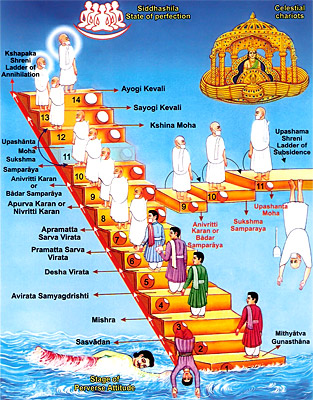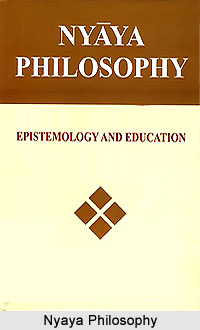 Fourteen Gunasthanas are classified in a logical manner, according to the principle of decreasing iniquitousness and of increasing purity, and not in chronological order in which they could pass. For relapses are possible in the case of every soul; they can throw down from the ascended stages and withdraw completely or partially the development made so far. This can be understood better when it is considered that the stay in many Fourteen Gunasthanas lasts for only few minutes so that it is quite possible that someone finds himself in the morning on a high stage, but falls down from it during noon and again and again climbs to it in the evening. But apart from the possibility of a relapse, it would be impossible to go through the entire 14 stages one after the other because a direct transition from the first stage to the second is ` out of question and the 11th stage is not directly passed before the 12th to the 14th.
Fourteen Gunasthanas are classified in a logical manner, according to the principle of decreasing iniquitousness and of increasing purity, and not in chronological order in which they could pass. For relapses are possible in the case of every soul; they can throw down from the ascended stages and withdraw completely or partially the development made so far. This can be understood better when it is considered that the stay in many Fourteen Gunasthanas lasts for only few minutes so that it is quite possible that someone finds himself in the morning on a high stage, but falls down from it during noon and again and again climbs to it in the evening. But apart from the possibility of a relapse, it would be impossible to go through the entire 14 stages one after the other because a direct transition from the first stage to the second is ` out of question and the 11th stage is not directly passed before the 12th to the 14th.
The fourteen Gunasthanas are as follows:
1. Mithyadristi Gunasthana: This stage is characterized by complete heterodoxy. Many souls, i.e. all those which are not capable of redemption, never come out of this stage. This applies also to those which are born as fully developed, irrational animals having 1 to 5 senses, as long as their existence lasts in this class of beings. Other are elevated from here, and mostly directly up to the fourth Gunasthana, but they can descend again to this stage and stay here for a while which would be minimally a fraction of a Muhurta and maximally somewhat lesser than 1/2 Pudgala-paravarta.
2. Sasvadana Samyagdristi Gunasthana, a stage in which there is a "taste of the right faith". Beings that had the "Aupasamika-faith" for a fraction of a Muhurta, but had lost it as a result of the eruption of life-long passions, are in this stage lasting only for one Samaya and at the most for 6 Avalikas. Accordingly, it is a condition lasting only for a short period; it lies between the stage in which heterodoxy was suppressed (like the 4th) and on the lowest when it has full force. The soul returns to the first Gunasthana after the expiry of this period. All the rational beings with five senses as also undeveloped animals of every type can be Sasvadanas.
3. Samyagmithyadristi Gunasthana: This stage in which the developed rational activities of all types can be found lasts only for a fraction of a Muhurta, once the period is over, the soul right or false faith as the conditions permit. Jivas falling from the 4th stage normally pass through Gunasthana.
4. Avirata Samyagdristi Gunasthana: Beings found in this stage i.e. rational beings of all types having five senses; have right faith but having still no self- discipline. Here a methodical suppression or destruction of the Karma can be begun on one of the two Srenis. The duration of this Gunasthana is a fraction of a Muhurta, and at least 33 Sagaropamas and a little at the most.
5. Desavirata Samyagdristi Gunasthana: In this the right faith and partially the self-discipline is present. This stage, which in contrast to the preceding one is not open to gods and beings from hell, but only to the fully developed rational animals and human beings, lasts at the most somewhat lesser than a Purvakoti, and at east a function of a Muhurta. The beings in this stage are either without a Sreni or they begin one of the Srenis, respectively are in one of them.
6. Pramatta Samyata Gunasthana: A complete self-discipline is achieved in this stage which is, like the following, accessible only to human beings. But if it has arisen out of flared-up passions, sleep, etc., it is disturbed by negligence (pramada).A transcendent knowledge of the thought for others can appear from this Gunasthana onwards. The duration of the stay in this stage is minimally samaya, maximally Muhurta. If someone dies after a Samaya he becomes Avirata (4th stage); if someone dies after a Muhurta is almost over, he becomes Desavirata (5th stage). If the Muhurta is over without any incident, the soul comes into the following, 7th stage in which (stays through a fraction of a Muhurta to return the Pramatta-gunasthana, after which the process begins anew. This oscillation between the 6th and the 7th Gunasthana lasts at the most somewhat less than a Purvakoti. This concerns ascetics who have not ascended any Sreni; if such is ascended or carried further, this sort of oscillation does not take place. It is characteristic of this stage that the body of transference is developed only in it.
7. Apramatta Samyata Gunasthana: Complete self-discipline without negligence is available in this stage. It last for 1Samaya to 1 Muhurta. The souls in this Gunasthana do not have any of the 6 Lesyas, like those of the preceding one, but only one of the three highest.
8. Apramatta Gunasthana. This stage, like the following one, is accessible only to a soul which is in a Sreni; only the white Lesya occurs now onwards. The process called Apurva-karana is carried out in it; the thoughts to which the one who is accomplish-s himself in his meditation, fill him with joys which he had never known before. One who is in an Upasama-sreni stays in this stage at least for 1 samaya and at the most 1 Muhurta and the one in the Kaspakasreni the whole period of a Muhurta.
9. Anivrtii Badara Sampardya Gunasthana: Here the soul in the Upasana- or Ksapaka-sreni accomplishes a process called "Anivrtti-karana". The former stay here at least for 1 Samaya, and at the most the duration of a Muhurta, the latter for a period of the duration of a Muhurta. It is characteristic of this stage that the so- called 6 "non-passions" do not appear any more in this stage, but the flaring-up passions do occur.
10. Suksma Sampardya Gunasthana: The three passions; anger, pride, deceit do not appear in this stage as also libido, but the flaring-up greed appears to, a negligible extent. The stay in this Gunasthana is 1 Samaya to 1 Muhurta in Upasama and the duration of, a Muhurta in Ksapaka.
11. Upasanta Kasayav Tiaraga Chadmastha Gunasthana: This is the highest stage that can be reached in the Upasama-sreni. Here all the passions are suppressed. This lasts at least for 1 Samaya and at the most for the duration of a Muhurta. The soul falls down from the Upasama-sreni after this and comes to one of the lower Gunasthanas.
12. Ksina Kasaya Vitaraga Chadmastha Gunasthana: This stage like all the following ones is attained by only the souls which have destroyed all the passions in the Ksapaka-sreni. When in the last Samaya whatever greed that is left over has been destroyed, the Ksapaka is in this stage where he remains for the duration of a Muhurta. He remains bound now an only the momentary Karma. In the last Samaya of his stay all the Karmas which restricted his knowledge, his seeing and his energy, disappear.
13. Sayogi Kevak Gunasthana: The saint is a kevali, an omniscient one, in this stage. The Sayogi-kevali knows everything, sees everything, is capable of everything, yet he has a body and a certain activity which is conditioned by matter, and a number of Karmas obtained earlier are produced in him; but as soon as the Karmas determining the quantum of life (Ayus) are exhausted, he annihilates all these. Accordingly, the Sayogi-condition lasts minimum for duration Muhurta and maximum somewhat less than a purvakoti the moment the period given to it ends the saint sinks into deep meditation and then ceases the inner activity of the mind, speech and body.
14. Ayogi Kevali Gunasthana: The saint has no activity (Yoga) and lesya in this transitory stage comprising only a period of Muhurta.












